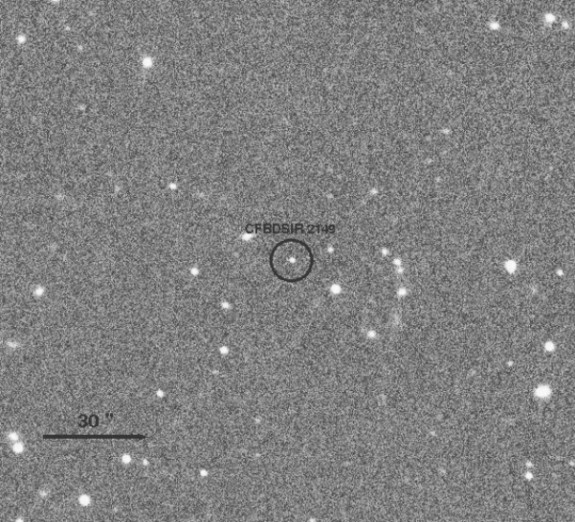Scientists Get The Best Look Yet at a Rogue Planet With No Star
A gas giant, drifting alone with no star to call home, was discovered 100 light-years away

The dot in the circle is the new rogue planet. Photo: Delorme et. al,
A planet four to seven times the size of Jupiter, a gigantic gaseous world with a balmy temperature of 400°C, has been found drifting aimlessly in the heavens above with no star for it to orbit, says the BBC, reporting on a new study. Computer simulations peg the newly-discovered planet at around 50 to 120 million years of age, a broad range for sure, but one of our best looks so far into a real-life “rogue planet.”
Rogue planets are planets just like any other, but because of either their formation mechanism or gravitational effects after their birth, they find themselves wandering the universe alone, not bound to any solar system. The BBC:
Rogue planets are believed to form in one of two ways: in much the same way as planets bound to stars, coalescing from a disk of dust and debris but then thrown out of a host star’s orbit, or in much the same way as stars but never reaching a full star’s mass.
Using a pair of super-powerful telescopes, researchers spotted the the rogue planet, dubbed the unforgettable “CFBDSIR214947.2-040308.9,” drifting around 100 light-years away.
The researchers are careful to caution that this is still a rogue planet “candidate,” but even so, its existence wouldn’t be particularly surprising. According to Bad Astronomy blogger Phil Plait, “free-floating planets in the Milky Way may outnumber planets orbiting stars, and even be more numerous than stars themselves.”
More from Smithsonian.com:
The Planet Hunters
Alpha Centauri Has a Planet
A Solar System Rich in Planets
/https://tf-cmsv2-smithsonianmag-media.s3.amazonaws.com/accounts/headshot/smartnews-colin-schultz-240.jpg)
/https://tf-cmsv2-smithsonianmag-media.s3.amazonaws.com/accounts/headshot/smartnews-colin-schultz-240.jpg)